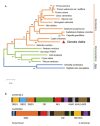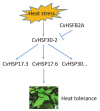One Heat Shock Transcription Factor Confers High Thermal Tolerance in Clematis Plants
- PMID: 33809330
- PMCID: PMC7998627
- DOI: 10.3390/ijms22062900
One Heat Shock Transcription Factor Confers High Thermal Tolerance in Clematis Plants
Abstract
Clematis plants play an important role in botanical gardens. Heat stress can destroy the activity, state and conformation of plant proteins, and its regulatory pathway has been well characterized in Arabidopsis and some crop plants. However, the heat resistance response mechanism in horticultural plants including Clematis has rarely been reported. Here, we identified a heat-tolerant clematis species, Clematis vitalba. The relative water loss and electrolytic leakage were significantly lower under heat treatment in Clematis vitalba compared to Stolwijk Gold. Differential expression heat-tolerant genes (HTGs) were identified based on nonparametric transcriptome analysis. For validation, one heat shock transcription factor, CvHSF30-2, extremely induced by heat stimuli in Clematis vitalba, was identified to confer tolerance to heat stress in Escherichia coli and Saccharomyces cerevisiae. Furthermore, silencing of HSF30-2 by virus-induced gene silencing (VIGS) led to heat sensitivity in tobacco and Clematis, suggesting that the candidate heat-resistant genes identified in this RNA-seq analysis are credible and offer significant utility. We also found that CvHSF30-2 improved heat tolerance of Clematis vitalba by elevating heat shock protein (HSP) expression, which was negatively regulated by CvHSFB2a. Taken together, this study provides insights into the mechanism of Clematis heat tolerance and the findings can be potentially applied in horticultural plants to improve economic efficiency through genetic approaches.
Keywords: Clematis; CvHSF30-2; CvHSFB2a; VIGS; heat stress; transcriptome analysis.
Conflict of interest statement
The authors declare no conflict of interest.
Figures








Similar articles
-
Insights into heat response mechanisms in Clematis species: physiological analysis, expression profiles and function verification.Plant Mol Biol. 2021 Aug;106(6):569-587. doi: 10.1007/s11103-021-01174-4. Epub 2021 Jul 14. Plant Mol Biol. 2021. PMID: 34260001
-
Proteome and transcriptome reveal the involvement of heat shock proteins and antioxidant system in thermotolerance of Clematis florida.Sci Rep. 2020 Jun 1;10(1):8883. doi: 10.1038/s41598-020-65699-2. Sci Rep. 2020. PMID: 32483281 Free PMC article.
-
A Heat-Shock Transcription Factor in Panax ginseng, PgHSFA2, Confers Heat and Salt Resistance in Transgenic Tobacco.Int J Mol Sci. 2025 Apr 18;26(8):3836. doi: 10.3390/ijms26083836. Int J Mol Sci. 2025. PMID: 40332497 Free PMC article.
-
Molecular insights into sensing, regulation and improving of heat tolerance in plants.Plant Cell Rep. 2022 Mar;41(3):799-813. doi: 10.1007/s00299-021-02793-3. Epub 2021 Oct 21. Plant Cell Rep. 2022. PMID: 34676458 Review.
-
Can wheat survive in heat? Assembling tools towards successful development of heat stress tolerance in Triticum aestivum L.Mol Biol Rep. 2019 Apr;46(2):2577-2593. doi: 10.1007/s11033-019-04686-x. Epub 2019 Feb 13. Mol Biol Rep. 2019. PMID: 30758807 Review.
Cited by
-
Mutagenic Effect of 60Co γ-Irradiation on Rosa multiflora 'Libellula' and the Mechanism Underlying the Associated Leaf Changes.Plants (Basel). 2022 May 28;11(11):1438. doi: 10.3390/plants11111438. Plants (Basel). 2022. PMID: 35684211 Free PMC article.
-
The Arabidopsis J-Protein AtDjC5 Facilitates Thermotolerance Likely by Aiding in the ER Stress Response.Int J Mol Sci. 2022 Oct 28;23(21):13134. doi: 10.3390/ijms232113134. Int J Mol Sci. 2022. PMID: 36361922 Free PMC article.
-
Genome-wide analysis of the HSF family in Allium sativum L. and AsHSFB1 overexpression in Arabidopsis under heat stress.BMC Genomics. 2024 Nov 11;25(1):1072. doi: 10.1186/s12864-024-11002-w. BMC Genomics. 2024. PMID: 39528922 Free PMC article.
-
FvHsfB1a Gene Improves Thermotolerance in Transgenic Arabidopsis.Plants (Basel). 2025 Aug 2;14(15):2392. doi: 10.3390/plants14152392. Plants (Basel). 2025. PMID: 40805739 Free PMC article.
-
Comparative transcriptome analysis of heat stress responses of Clematis lanuginosa and Clematis crassifolia.BMC Plant Biol. 2022 Mar 23;22(1):138. doi: 10.1186/s12870-022-03497-w. BMC Plant Biol. 2022. PMID: 35321648 Free PMC article.
References
-
- Beutler L. The Rogerson Clematis Collection: Where Every Garden Tells a Story. Pacific Horticulture Society; Berkeley, CA, USA: 2014.
-
- Chohra D., Ferchichi L., Selim Y., Gokhan C., Sarah Z., Alsheikh M. Phenolic profiles, antioxidant activities and enzyme inhibitory effects of an Algerian medicinal plant (Clematis cirrhosa L.) S. Afr. J. Bot. 2020;132:164–170. doi: 10.1016/j.sajb.2020.04.026. - DOI
-
- Hassan M.U., Chattha M.U., Khan I., Chattha M.B., Aslam M.T. Heat stress in cultivated plants: Nature, impact, mechanisms, and mitigation strategies - A review. Plant Biosyst. 2020;7:1–56. doi: 10.1080/11263504.2020.1727987. - DOI
MeSH terms
Substances
Grants and funding
- 18DZ2283500/Science and Technology Commission of Shanghai Municipality
- 17DZ2252700/Shanghai Engineering Research Center of Plant Germplasm Resources
- 18DZ2260500/Science and Technology Commission of Shanghai Municipality
- 2018YFD1000400/Shanghai Key Laboratory of Plant Molecular Sciences National Key R&D Program of China
LinkOut - more resources
Full Text Sources
Other Literature Sources

